

Skills aren’t soft or hard — they’re durable or perishable. The term “soft skills” is often met with an eye-roll these days.
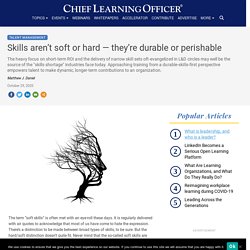
It is regularly delivered with air quotes to acknowledge that most of us have come to hate the expression. There’s a distinction to be made between broad types of skills, to be sure. But the hard/soft distinction doesn’t quite fit. Never mind that the so-called soft skills are actually the hard ones — they are more challenging to obtain and require a deeper and more enduring commitment. Some organizations have kept the same simple bifurcation in their skills frameworks but rebranded soft skills as “human skills” or “power skills.” Tim Brown of IDEO popularized the concept of T-shaped talent, and most organizations have bought in. In reality, these seemingly perpendicular categories are deeply intertwined. The growing interdependence of human and technical skills is not the only factor that demands new skill-development frameworks. Are skills more durable or more perishable? Planning for long-term needs Matthew J.
Virtual Meeting Best Practices: Tips for Improving the Viewing Experience. Earlier this year, I welcomed Jaime Casap, (then) Chief Education Evangelist from Google, to our webcast series titled Finding Happiness Through Challenges.
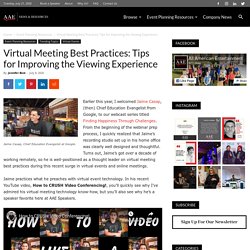
From the beginning of the webinar prep process, I quickly realized that Jaime’s recording studio set up in his home office was clearly well designed and thoughtful. Turns out, Jaime’s got over a decade of working remotely, so he is well-positioned as a thought leader on virtual meeting best practices during this recent surge in virtual events and online meetings. Jaime practices what he preaches with virtual event technology. In his recent YouTube video, How to CRUSH Video Conferencing! , you’ll quickly see why I’ve admired his virtual meeting technology know-how, but you’ll also see why he’s a speaker favorite here at AAE Speakers.
10 Steps to Managing Learning Projects. Many learning professionals are unexpected project managers.
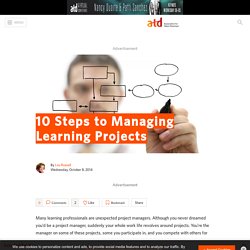
Although you never dreamed you’d be a project manager, suddenly your whole work life revolves around projects. You’re the manager on some of these projects, some you participate in, and you compete with others for scant resources. The project manager with the organizational skills necessary to manage this project maze will thrive. Here is a brief overview of 10 steps to successful project management. Step 1: Decide if you have a real project to manage Many learning professionals unexpectedly become project managers. Step 2: Prove your project is worth your time In both profit and nonprofit entities, there is a limited amount of money and a finite number of people to get things done.
Step 3: Manage scope creep Ask 100 people if documenting scope is critical to project success, and I bet that 99 percent of them would say “yes.” Step 4: Identify, rate, and manage risks.
How Long to Develop One Hour of Training? Updated for 2017. This article is an update to a study that tried to answer the question: How long it takes to design one hour of instruction?

It presents a comparison of findings from 2003, 2009, and 2017. It’s hard to believe that it has been roughly 14 years since Dr. Karl Kapp first tried to address the question: How long does it take to develop one hour of employee training? In 2009, as innovations in authoring tools and simulated learning started to permeate the market, it became clear that L&D professionals needed new answers to this fundamental question. Karl and I gladly took to that request and expanded the understanding of developmental hours and common challenges practitioners face when producing training. The AGES Model can help learning stick. Most corporate learning programs are designed to be popular.
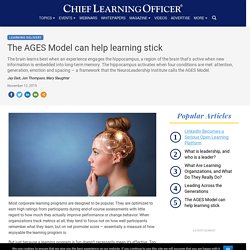
They are optimized to earn high ratings from participants during end-of-course assessments with little regard to how much they actually improve performance or change behavior. When organizations track metrics at all, they tend to focus not on how well participants remember what they learn, but on net promoter score — essentially a measure of how enjoyable the learning program is.
But just because a learning program is fun doesn’t necessarily mean it’s effective. Personal Learning Environments Networks and Knowledge. As a facilitator and professor at university, I am interesting on reflecting, reading and learning about learning environment and learning experiences, specially the ones that emerged through on line communities.
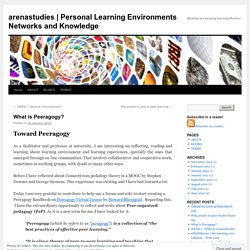
That involves collaborative and cooperative work, sometimes in working groups, with dyads or many other ways. Before I have reflected about Connectivism pedadogy theory in a MOOC by Stephen Downes and George Siemens. This experience was exciting and I have had learned a lot. What Are Micro Credentials and How Can They Benefit You? - Training.com.au.
Training Industry Magazine - Winter 2016. Virtual New Hire Techniques that Work! □ Remember your first day of work at your last or current job?

Did you feel the warm fuzzies? Did you feel welcomed, supported, guided? I hope so, because that is how you are supposed to feel on the first day. Your first day should be about joining the team. However, it mostly seems as though it's about mountains of paperwork and endless PowerPoint presentations.
Remote Learning. Tools. The Seek > Sense > Share Framework. Seek Sense Share — Inside Learning Technologies [This article appears in Inside Learning Technologies January 2014] Simple standards facilitated with a light touch, enables knowledge workers to capture, interpret, and share their knowledge. Personal knowledge mastery is a set of processes, individually constructed, to help each of us make sense of our world and work more effectively.
But what we loosely call knowledge, using terms like knowledge-sharing or knowledge capture, is just an approximation. We are not very good at articulating our knowledge, says knowledge management expert Dave Snowden: “We always know more than we can say, and we will always say more than we can write down.” Becoming knowledgeable can be thought of as bits of knowledge partially shared and experienced over time. Merely being well-read is not enough to be knowledgeable, as possibly first noted by Socrates. The Seek, Sense, Share Framework Capturing knowledge, as crudely as we do, is just a first step.